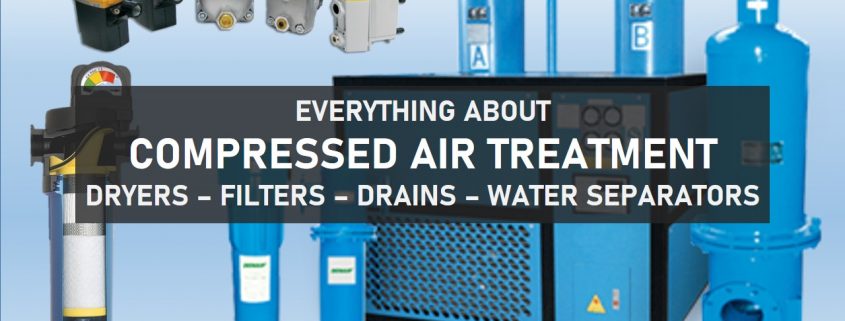Compressed Air Treatment and its Components
The correct compressed air treatment can significantly improve the machine’s process and production reliability. Particles, water and oil in compressed air will shorten the life and function of components and systems. They can also damage productivity and energy efficiency.
Why Compressed Air Filtration is Necessary
One cubic foot of compressed air may contain millions of dust particles, large amounts of water and oil, and even heavy metals such as lead, cadmium and mercury. If it is not filtered out, the trouble-free operation of system components (such as valves and cylinders) cannot be guaranteed for a long time. Inadequate treatment of compressed air can contaminate the control valve and cause seal ring expansion and premature wear.
Types of Filters and Air Treatment Equipment
There are many types of air treatment components that can be used to remove pollutants, such as solid particles, liquid water, water vapor and oil vapor, odorants, and even bacteria and viruses. For most automation applications, the focus is on removing solid particles and water.
The water separator adopts a centrifugal design or coalescence principle to remove condensate.
- The centrifugal separator causes a rotational movement in the air, forcing the particles to accelerate in a radially outward movement. Once it reaches the outside, it drains into the bowl. These effectively remove water droplets and dust and dirt particles larger than 5 microns. This process requires no maintenance.
- The coalescing filter allows air to flow from the inside of the filter element to the outside. These filter cartridges must be replaced regularly.
Filters are used to remove particles, condensate and oil.
- The coarse/particulate filter has a pore size of 5 to 40 microns. The air flows through the centrifugal separator and then through the filter element. The filter element is usually a sintered material, such as polyethylene or bronze.
- Fine filters and microfilters remove particles smaller than 1 micron (down to 0.01 micron). Air flows from the inside to the outside of the filter element. The solid particles are stuck in the filter element, clogging the filter element. Fluid particles such as condensate or oil can coalesce or adhere to larger droplets, which can float and become trapped in the filter bowl. It is important to cascade filters to avoid premature clogging of filter elements.
- The activated carbon filter combines hydrocarbon residues, odorants and oil vapors.
- The sterile filter ensures that the air is free of bacteria.
There are several different types of drain pipes for the filter unit:
- Manual: Tighten the drain plug to manually drain the condensate. These require regular maintenance schedules (i.e. once per shift).
- Semi-automatic/normally open: This type of drain opens immediately after the compressed air is closed.
- Fully automatic/normally open: This type of drain will open immediately when the compressed air is cut off or the bowl reaches the specified water level.
- Fully automatic/normally closed: These filters will open after turning on the compressed air and reaching the specified liquid level in the filter bowl.
- There is also an electric drain pipe, which can be opened/closed remotely by electric signals.
Dryers are used to remove water vapor that exceeds the capabilities of fine and micro coalescing filters and is classified according to the available pressure dew point (PDP). The pressure dew point defines the temperature to which compressed air can be cooled without condensing. Following are the major types of compressed air dryers
- The refrigeration dryer is commonly located downstream of the factory air compressor. The air is cooled to just freezing in the cooling device, and the discharged condensate is discharged. The pressure dew point reached is approximately 3°C (37°F).
- The membrane dryer suppresses the pressure dew point related to the inlet conditions. Air flows longitudinally through a bundle of parallel hollow fibers. In this process, water vapor diffuses due to the local pressure drop from the inside of the fiber to the outside.
- When the pressure dew point is -40°F (-40°C) to -94°F (-70°C), an adsorption dryer can be used. The dryer uses molecular forces to bind gas or vapor molecules to a desiccant, such as desiccant beads. Since the desiccant is renewable, two chambers are required. When one of them dries, the other desiccant has time for cold or hot regeneration.
Properly Maintaining Filter Elements
- In order to maintain the effective operation of the filter, the filter element needs to be replaced regularly. How often an operation needs to be performed depends on variables such as the quality of the air supplied and the operating time of the machine.
A more reliable method is to use a differential pressure sensor, which measures the pressure drop between the air supply and output pressure of the filter. The pressure drop indicates when the filter is clogged. These can be electrical sensors that send signals to the PLC, which can then alert the operator, or can be visual indicators of the filter unit itself.
Feel free to contact us with your reliable Compressed Air service partner Sakoon Pneumatics.




Leave a Reply
Want to join the discussion?Feel free to contribute!